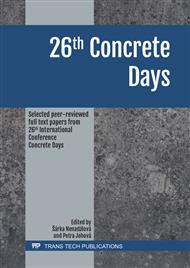p.44
p.51
p.57
p.62
p.68
p.73
p.80
p.87
p.93
Resistance of Concrete with Surface Treatment against Chemical Deicing Agents
Abstract:
The paper presents the results of measurement of resistance of concrete with surface treatment against water with deicing chemicals. Surface treatment of the test specimens was performed by sandblasting using steel balls. The effect of sandblasting was measured on normal strength aerated concrete (NC) and high strength concrete (UUHPC). Aerated concrete gains its resistance to water with deicing chemicals mainly due to its pores structures, while UUHPC due to the low porosity and low water absorption of the cement matrix. The sandblasting of the specimens simulated the required surface finish or mechanical deterioration of the concrete.
Info:
Periodical:
Pages:
68-72
Citation:
Online since:
August 2020
Authors:
Price:
Сopyright:
© 2020 Trans Tech Publications Ltd. All Rights Reserved
Share:
Citation:


